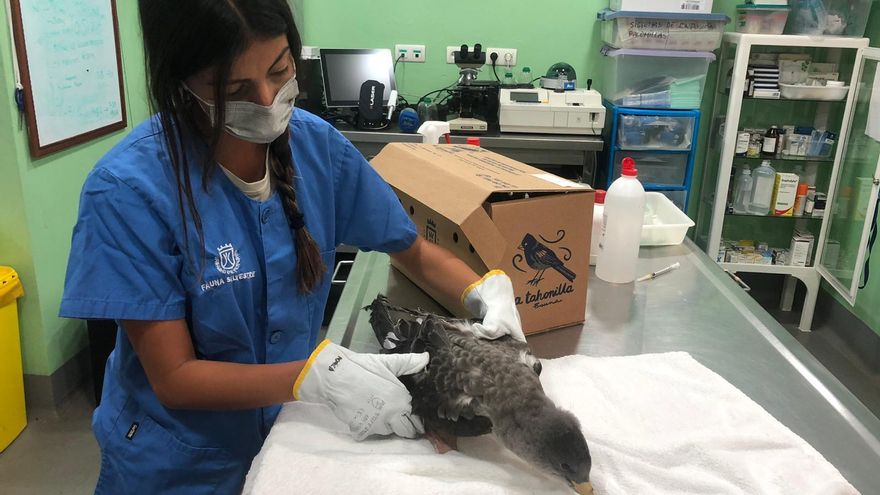
The rat and mouse traps are one of the main causes of damage to the island’s birds. The glue used adheres to their wings and can kill them. It is one of the human factor incidents in wild fauna that is repeated with other protected wild species such as the bat. All of them are attended at La Tahonilla, the Cabildo Recovery Center. One of its veterinarians, Alejandro Suárez Pérez, reveals a paradox: «Killing rodents through these systems means doing it with their main predators, owls and kestrels. In the case of bats it is the same because they are eternal enemies of insects and help to eliminate them ».
Suárez explains that “these prohibited traps for rats attract birds and damage them, as shown by the data of the 26 recovered in 2021.” As for the bats, he relates: «There was another episode recently in La Laguna with the capture of a dozen specimens of protected species. As an anecdote, in Puerto de la Cruz a woman caught eight after putting glue on the roof. I was unaware that it was forbidden. That does not exempt her but be flexible and inform rather than punish». The exception is “the usual offenses.”
A terrible balance on rodenticides: «98% of the kestrels we treat have metabolites of the product in their body and many die because of it.
Alejandro clarifies: «The urbanites do not realize it, but there is also fauna in the city». Especially birds: kestrels, owls, aviuvillas, robins, sparrows, … The vet insists: “A trap that uses glue is legal, but only indoors.” Never outside, precisely because of the possible damage to wild species. “It is a serious problem, more than it seems”, sentence.
Another example: “Lizards are killed in this land with great ease. Like the bat, it is an animal with a bad reputation. I do not know why. Due to ignorance or otherwise it is something frequent ».
Poison is another problem because “here it is used quite naturally because of tradition, it is deeply rooted in the population. Plus, very toxic poisons, much more than the current ones that have been saved and are already absolutely prohibited. In this regard, he values: «In recent weeks there have already been two dead crows as a result of these practices. The poison is used to kill cats, the crow eats it and dies. This is included as a crime in the Penal Code.
Alejandro takes stock: «We receive an average of 5,000 animals per year to recover. In 2021 there were 3,400 birds and about 2,000 of other species. 55% is returned to the natural environment, since we can only do it if the specimen is in perfect condition. Sometimes they arrive very badly, with already irrecoverable wounds or fractures ».
Suárez gives the example of the turtle caretta caretta, “misnamed loggerhead”, since there are many who arrive at La Tahonilla: “All are affected by the pollution of the sea and one hundred percent defecate plastics.” He adds that “in Gran Canaria they almost always strand along the coast while here, in Tenerife, as the coast is more abrupt, it is normal for a ship to pick it up, take it to port and we will look for it.” The island councilor, Isabel García, highlights the arrival of these marine animals. In the center they are recovered and then the turtles are released and returned to the environment. This year we had a very interesting case, that of a specimen that had lost buoyancy, and after several clinical studies at the center it was possible to intervene and improve.
What the La Tahonilla staff will not look for are the domestic mammals such as cats, dogs, or rabbits. But the vet clarifies: «If they bring them to us, we take care of and if possible we cure any animal. We refer cats and dogs to protectors ».
The injured specimens arrive at La Tahonilla after being collected by citizens, police forces or other collaborating entities. The months with the most are May, June and July.
Suárez arrived at his post in May 2021. He explains: «I am from Gran Canaria and the square was uncovered; The opportunity arose and I came. It is a very nice job even if the family has it far away. Advocates more than sanctions «awareness campaigns» because it would not be about prohibiting but about informing. Binds it to your desire to that “sometime these centers do not make sense because damaged animals do not enter”. Especially by the hand of man.
“A benchmark at the national level”
The La Tahonilla Wildlife Recovery Center (CRFS), located on the La Esperanza road, in La Laguna, belongs to the Natural Environment and Safety Management area of the Cabildo. The island councilor, Isabel García, describes it as a “national benchmark” in a territory where there are many threatened or endangered species. It complements its task with environmental education and training tasks. The counselor values that “most damage to wildlife is caused by humans.” It highlights in this regard “the more than 25 birds that during 2021 were admitted with remains of glue on their wings.” He adds “the intense work carried out between October and November by a team from the center”, together with volunteers, civil protection and local police in the campaign to collect the ashen shearwater chickens that fall attracted by artificial light.
















